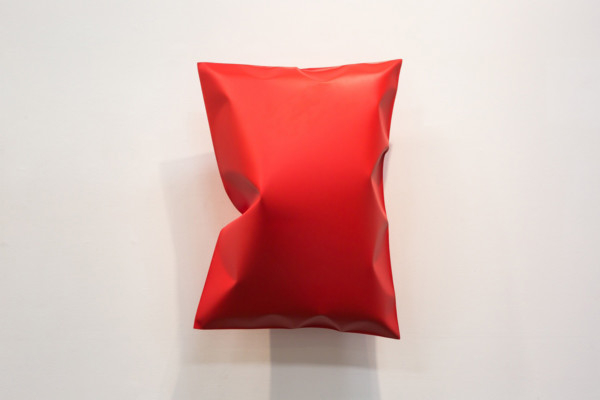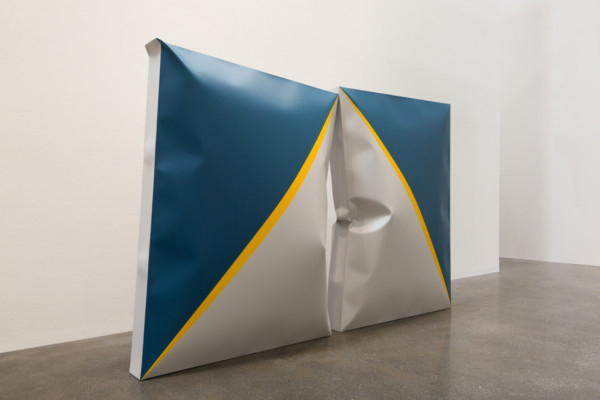
Shaikha Al Mazrou has made her mark as one of the shining stars of the third generation of contemporary Emirati artists with her innovative sculptures, installations and large scale commissioned works.
The young artist received her master’s from the Chelsea College of Fine Art, University of the Arts London in 2014 and now teaches sculpture at the College of Fine Arts and Design, Sharjah from where she graduated in 2010. Al Mazrou’s minimalist, conceptual practice is influenced by artists such as Donald Judd, Sol Lewitt and Carle Andre. She is fascinated by notions of physical space and experiments with various materials to create artworks that emphasize the representation of tension, weight and space.
For her debut solo show, Expansion / Extension the artist has expanded and extended her research into the meaning of sculpture, material and its representational function to create a series of seven sculptures that play with positive and negative tension and illusions of colour and material. The abstract sculptures appear to be soft, spongy and malleable, but in fact they are made of steel. They are coated with different tones and combinations of bright colours that emphasize their geometric forms and play with our sense of perspective and space.
Al Mazrou spoke to the Weekend Review about her work, inspirations and artistic experiments. Excerpts:
What is the concept behind this body of work?
My practice is essentially about structure, balance, tension and space, but I have an endless hunger to learn more about materials and their possibilities. In this body of work, I wanted to challenge the perception of material. I have worked with poured steel before, but here I experimented with flat sheets of stainless steel that are extremely hard to manipulate and made them seem soft, light and squishy. The sculptures have been created by welding steel sheets together and expanding them under pressure, so the show’s title refers to the expansion of the material as well as the extension of my practice. I enjoyed the process and its possibilities because although I could control the size and expansion of the material I had no control over the folds that formed. I have put a lot of thought into the size, shape, colours and display of the pieces to emphasize the contradictions and illusions and facilitate a dialogue with viewers.
Was the sculpture titled Engage planned as a diptych?
I was curious to see what happens when I inflate two rectangular shapes together. When I applied the pressure, they started leaning towards each other as if they were talking and supporting one another and stayed like that even after the pressure was removed. I have a playful, light-hearted approach to my practice and enjoy such unexpected results, so I decided to display them on the floor in the same position. I titled the work Engage because I feel there is a human energy in these sculptures and they are engaging with each other.
Why did you combine glass with steel in Exhale?
I wanted to add another material to create an extra layer of tension in this work. The sheet of coloured glass I have used weighs 100 kg. I was told that it was impossible for the steel to support this weight, but that just made me want to take up the challenge even more. I did a lot of research on glass and artists who worked with glass and experimented with folding the steel, controlling it differently and exploring other possibilities with the material. The result is a piece where the glass appears to be creating a fold in the steel ‘pillow’ that is in fact supporting it and the tension is palpable.
Has your practice been influenced by the earlier generations of contemporary Emirati artists?
I was fortunate to get the opportunity to interact with the late Hassan Sharif right from my student days. Our college took us on visits to The Flying House where we interacted with Sharif and other artists of that generation who have shaped the contemporary art scene in the UAE. Sharif always encouraged and supported my work, and Mohammed Kazem has been a wonderful mentor and friend to me. They believed in my practice when I was still a student and have helped me by including my work in important group shows curated by them, mentoring me and always being there to discuss and critique my work.
As a young Emirati artist, how do you see the evolution of the art scene in the UAE?
During my time, my college was the only one offering a degree in fine arts and there were just four students in my batch. Today I am teaching at the college and can see how much the number of students has increased. This is because the art scene is growing and there is greater awareness about the possibilities of art as a career. The government supports young artists through commissions and events such as Sikka Art Fair, Abu Dhabi Art and others, and the new museums are also platforms for educating the public about the importance of art. With the growing number of galleries and other institutions, young artists today have a lot of opportunities if they are willing to work hard, do research and develop their practice, and keep learning and growing. But I do wish there would be more universities offering graduate and post graduate courses in fine art and the school curriculum included a basic familiarisation with regional and international art.
Does teaching art help you as an artist?
Absolutely. As a teacher I try to inspire my students and in turn they inspire me with their fresh outlook and amazing ideas. The discussions, dialogue and sharing of ideas with students is always stimulating and keeps me thinking. During the vacations I still go to the campus to work on my own practice because the environment keeps the artist in me alive. This entire body of work was created on campus during the summer break.
Jyoti Kalsi is an arts-enthusiast based in Dubai.
Expansion / Extension will run at Lawrie Shabibi gallery, Alserkal Avenue, Al Quoz, until November 1.













